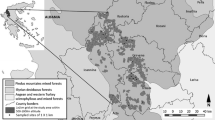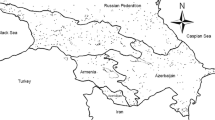Abstract
The knowledge on the geographical distribution of species is essential for building biogeographical and macroecological hypotheses. However, information on this regard is not distributed uniformly in space and usually come from biased sampling. The aim of this study is to quantify the influence of spatial distribution of sampling effort on the assessment of spider species richness in Brazil. We used a database of spider distribution records in Brazil, based on the taxonomic and biodiversity survey literature. The results show that the Atlantic Forest was better sampled and had the highest spider species richness among the Brazilian biomes. The Amazon, though having large collecting gaps and high concentration of records around major cities and rivers, showed the second highest number of species. The Pampa had a large number of records, but these are concentrated near a major city in the transition zone with the Atlantic Forest. The Cerrado, Caatinga and Pantanal had shown to be poorly sampled and, consequently, were among the lesser known biomes regarding the spider fauna. A linear regression analysis showed that the spider species richness in Brazil is strongly correlated to the number of records. However, we have identified areas potentially richest in species, which strongly deviate from the predicted by our analyses. Our results show that it is possible to access the spatial variation in species richness, as long as the variation in sampling effort is taken into account.



Similar content being viewed by others
References
Azevedo JAR, Valdujo PH, de Nogueira CC (2016) Biogeography of anurans and squamates in the Cerrado hotspot: coincident endemism patterns in the richest and most impacted savanna on the globe. J Biogeogr 43:2454–2464. doi:10.1111/jbi.12803
Beatie AJ, Oliver I (1994) Taxonomic minimalism. Trends Ecol Evol 9:488–490
Bellini BC, Zeppelini D (2008) A new species of Seira (Collembola: Entomoborydae) from northeastern Brazil. Rev Bras Zool 25:724–727
Bonaldo AB, Brescovit AD, Höfer H et al (2009) A araneofauna (Arachnida, Araneae) da Reserva Florestal Adolpho Ducke, Manaus, Amazonas, Brasil. In: Da Fonseca CRV, Magalhães C, Rafael JA, Franklin EN (eds) A fauna de artrópodes da Reserva Florestal Ducke Estado Atual do Conhececimento Taxonômico e Biológico. INPA, Manaus
Brandon K, da Fonseca GAB, Rylands AB, da Silva JMC (2005) Brazilian conservation: challenges and opportunities. Conserv Biol 19:595–600
Brescovit AD (1999) Araneae. In: Joly CA, Bicudo CEM (eds) Biodiversidade do Estado de São Paulo, Brasil: síntese do conhecimento ao final do século XX. Vol. 5, Invertebrados terrestres. FAPESP, São Paulo, pp 47–56
Brooks TM (2006) Global biodiversity conservation priorities. Science 313(5783):58–61
Brose U, Martinez ND, Williams RJ (2003) Estimating species richness: sensitivity to sample-coverage and insensitivity to spatial patterns. Ecology 84:2364–2377
Buckup EH, Marques MAL, Rodrigues ENL, Ott R (2010) Lista das espécies de aranhas (Arachnida, Araneae) do estado do Rio Grande do Sul, Brasil. Iheringia 100:483–518
Carbayo F, Froehlich M, Bettio A, Universit C (2008) Estado do conhecimento dos macroturbelários (Platyhelminthes) do Brasil. Biota Neotropica 8:177–197
Cardosa DBOS, Queiroz LP (2008) A new species of Senna (Leguminosae, Caesalpinoideae) from Eastern Brazil. A J Bot Nomencl 18:140–143
Coddington JA, Levi HW (1991) Systematics and evolution of spiders (Araneae). Annu Rev Ecol Syst 22:565–592
Coddington JA, Griswold CE, Dávila DS et al (1991) Designing and testing sampling protocols to estimate biodiversity in tropical ecosystems. In: Dudley EC (ed) The unity of evolutionary biology: preoceedings of the fourth international congress of systematic and evolutionary biology. Dioscoride, Portland, pp 44–60
Collen B, Ram M, Zamin T, Mcrae L (2008) The tropical biodiversity data gap: addressing disparity in global monitoring. Trop Conserv Sci 1:75–88
Costa LP, Leite YLR, Fonseca GAB, Fonseca MT (2000) Biogeography of South American forest mammals: endemism and diversity in the Atlantic Forest. Biotropica 32:872–881
Culik MP, Zeppelini-Filho D (2003) Diversity and distribution of Collembola (Arthropoda: Hexapoda) of Brazil. Biodivers Conserv 12:1119–1143
De Marco P, Vianna DM Jr (2005) Distribuição do esforço de coleta de Odonata no Brasil – subsídios para escolha de áreas prioritárias para levantamentos faunísticos. Lundiana 6:13–26
Dean W (1997) With broadax and firebrand: the destruction of the Brazilian Atlantic Forest. University of California Press, Berkeley
Dennis RLH, Sparks TH, Hardy PB (1999) Bias in butterfly distribution maps: the effects of sampling effort. J Insect Conserv 3:33–42
Diniz-Filho JAF, De Marco P Jr, Hawkins BA (2010) Defying the curse of ignorance: perspectives in insect macroecology and conservation biogeography. Insect Conserv Divers 3:172–179. doi:10.1111/j.1752-4598.2010.00091.x
Ferrier S, Powell GVN, Richardson KS et al (2010) Mapping more of terrestrial biodiversity for global conservation assessment. Bioscience 54:1101–1109
France R, Rigg C (1998) Examination of the “founder effect” in biodiversity research: patterns and imbalances in the published literature. Divers Distrib 4:77–86
Françoso RD, Brandão R, Nogueira CC et al (2015) Habitat loss and the effectiveness of protected areas in the Cerrado biodiversity hotspot. Nat Conserv 13:35–40. doi:10.1016/j.ncon.2015.04.001
Freitag S, Hobson C, Biggs HC, Van Jaarsveld AS (1998) Testing for potential survey bias: the effect of roads, urban areas and nature reserves on a southern African mammal data set. Anim Conserv 1:119–127
Gaston KJ (2000) Global patterns in biodiversity. Nature 405:220–227
Gaston KJ, May RM (1992) Taxonomy of taxonomists. Nature 356:281–282
Graham CH, Hijmans RJ (2006) A comparison of methods for mapping species ranges and species richness. Glob Ecol Biogeogr 15:578–587. doi:10.1111/j.1466-822x.2006.00257.x
Grand J, Cummings MP, Rebelo TG et al (2007) Biased data reduce efficiency and effectiveness of conservation reserve networks. Ecol Lett 10:364–374. doi:10.1111/j.1461-0248.2007.01025.x
Harris MB, Tomas W, Mourão G et al (2005) Safeguarding the Pantanal wetlands: threats and conservation initiatives. Conserv Biol 19:714–720. doi:10.1111/j.1523-1739.2005.00708.x
Heltshe JF, Forrester NE (1983) Estimating species richness using the jackknife procedure. Biometrics 39:1–11
Henderson IM (1991) Biogeography without area? Aust Syst Bot 4:59–71
Heyer WR, Coddington J, Kress WJ et al (1999) Amazonian biotic data and conservation decisions. Environ Biodivers 51:372–385
Hijmans RJ, Guarino L, Jarvis A et al. (2009) DIVA-GIS, version 5.2. Program and documentation. http://www.diva-gis.org
Hopkins MJG (2007) Modelling the known and unknown plant biodiversity of the Amazon basin. J Biogeogr 34:1400–1411. doi:10.1111/j.1365-2699.2007.01737.x
Kier G, Mutke J, Dinerstein E et al (2005) Global patterns of plant diversity and floristic knowledge. J Biogeogr 32:1107–1116. doi:10.1111/j.1365-2699.2005.01272.x
Klink CA, Machado RB (2005) Conservation of the Brazilian Cerrado. Conserv Biol 19:707–713
Kress WJ, Heyer WR, Acevedo P et al (1998) Amazonian biodiversity: assessing conservation priorities with taxonomic data. Biodivers Conserv 7:1577–1587
Leal IR, Silva JMC, Tabarelli M, Lacher TE (2005) Changing the course of biodiversity conservation in the Caatinga of northeastern Brazil. Conserv Biol 19:701–706
Levi HW (2007) The orb weaver genus Mangora in South America (Araneae, Araneidae). Bull Mus Comp Zool 159:1–144
Lewinsohn TM, Prado PI (2004) Biodiversidade Brasileira: Síntese do estado atual do conhecimento, 2nd edn. Contexto, São Paulo
Lewinsohn TM, Prado PI (2005) How many species are there in Brazil? Conserv Biol 19:619–624
Lewinsohn TM, Freitas AVL, Prado PI et al (2005) Conservation of terrestrial invertebrates and their habitats in Brazil. Conserv Biol 19:640–645
Lise AA (1998) Arachnids of the Ilha de Maracá - Notes on the spiders of the Ilha de Maracá. In: Milliken W, Ratter J (eds) Maracá the biodiversity & environment of an Amazonian rainforest. Wiley, Hoboken, pp 377–380
Magalhães ILF, Brescovit AD, Santos AJ (2013) The six-eyed sand spiders of the genus Sicarius (Araneae: Haplogynae: Sicariidae) from the Brazilian Caatinga. Zootaxa 3599:101–135. doi:10.11646/zootaxa.3599.2.1
Mittermeier RA, Gil PR, Mittermeier CG (1997) Megadiversity: Earth’s biologically wealthiest nations. In: Mittermeier RA (ed) CEMEX. Agrupación Serra Madre, S.C, Mexico
Myers N, Mittermeier RA, Mittermeier CG et al (2000) Biodiversity hotspots for conservation priorities. Nature 403:853–858. doi:10.1038/35002501
Nelson BW, Ferreira CAC, da Silva MF, Kawasaki ML (1990) Endemism centres, refugia and botanical collection density in Brazilian Amazonia. Nature 345:714–716
Oliveira U, Brescovit AD, Santos AJ (2015) Delimiting areas of endemism through kernel interpolation. PLoS ONE. doi:10.1371/journal.pone.0116673
Oliveira U, Paglia AP, Brescovit AD et al (2016) The strong influence of collection bias on biodiversity knowledge shortfalls of Brazilian terrestrial biodiversity. Divers Distrib 22:1232–1244. doi:10.1111/ddi.12489
Platnick, NI (2000–2009) The World Spider Catalog, Version 10.0. The American Museum of Natural History
Peres CA (2005) Why we need Amazonian mega-reserves. Conserv Biol 19:728–733
Pinheiro-Machado C, Alves-dos-Santos I, Imperatriz-Fonseca VL et al (2002) Brazilian bee surveys: state of knowledge, conservation and sustainable use. Ministério do Meio Ambiente, Brasilia
Rangel TF, Diniz-filho JAF, Bini LM (2010) SAM: a comprehensive application for spatial analysis in macroecology. Ecography 33:46–50. doi:10.1111/j.1600-0587.2009.06299.x
Santos JC, Leal IR, Almeida-Cortez JS et al (2011) Caatinga: the scientific negligence experienced by a dry tropical forest. Trop Conserv Sci 4:276–286
Sastre P, Lobo JM (2009) Taxonomist survey biases and the unveiling of biodiversity patterns. Biol Conserv 142:462–467. doi:10.1016/j.biocon.2008.11.002
Schneider M, Peres CA (2015) Environmental costs of government-sponsored agrarian settlements in Brazilian Amazonia. PLoS ONE 10:e0134016. doi:10.1371/journal.pone.0134016
Schulman L, Toivonen T, Ruokolainen K (2007) Analysing botanical collecting effort in Amazonia and correcting for it in species range estimation. J Biogeogr 34:1388–1399. doi:10.1111/j.1365-2699.2007.01716.x
Soares-Filho B, Rajao R, Macedo M et al (2014) Cracking Brazil’s forest code. Science 344(6182):363–364. doi:10.1126/science.1246663
Sobral M, Stehmann JR (2009) An analysis of new angiosperm species discoveries in Brazil (1990–2006). Taxon 58:227–232
Soria-Auza RW, Kessler M (2008) The influence of sampling intensity on the perception of the spatial distribution of tropical diversity and endemism: a case study of ferns from Bolivia. Divers Distrib 14:123–130. doi:10.1111/j.1472-4642.2007.00433.x
Walther BA, Moore J (2005) The concepts of bias, precision and accuracy, and their use in testing the performance of species richness estimators, with a literature review of estimator performance. Ecography 28:815–829
Wang JP (2011) SPECIES: an R package for species richness estimation. J Stat Softw 40:1–15
Whittaker RJ, Araújo MB, Jepson P et al (2005) Conservation biogeography: assessment and prospect. Divers Distrib 11:3–23
Wise DH (1993) Spiders in ecological webs. Cambridge University Press, Cambridge
World Spider Catalog (2016) World spider catalog. Natural History Museum Bern. http://wsc.nmbe.ch, version 17.5. Accessed 1 Dec 2016. http://research.amnh.org/entomology/spiders/catalog/index.html. Accessed 20 Apr 2009
Zhang Z (2013) Animal biodiversity: an update of classification and diversity in 2013. In: Zhang Z.-Q. (ed) Animal biodiversity: an outline of higher-level classification and survey of taxonomic richness (Addenda 2013). Zootaxa 3703:5. doi: 10.11646/zootaxa.3703.1.3
Acknowledgements
We would like to thank Ivan L. F. Magalhães for innumerable discussions, sharing of ideas and critical readings of early versions of the manuscript. This study is part of U. Oliveira’s Master dissertation at “Ecologia Conservação e Manejo da Vida Silvestre” graduate program at UFMG. A. J. Santos was sponsored by research grants from CNPq (407288/2013-9; 306222/2015-9), FAPEMIG (PPM-00335-13, PPM-00651-15) and Instituto Nacional de Ciência e Tecnologia dos Hymenoptera Parasitóides da Região Sudeste Brasileira (http://www.hympar.ufscar.br/). A. D. Brescovit received finantial support from CNPq (301776/2004-0) and Fundação de Amparo à Pesquisa do Estado de São Paulo (2011/50689-0).
Author information
Authors and Affiliations
Corresponding author
Additional information
Communicated by Akihiro Nakamura.
Rights and permissions
About this article
Cite this article
Oliveira, U., Brescovit, A.D. & Santos, A.J. Sampling effort and species richness assessment: a case study on Brazilian spiders. Biodivers Conserv 26, 1481–1493 (2017). https://doi.org/10.1007/s10531-017-1312-1
Received:
Revised:
Accepted:
Published:
Issue Date:
DOI: https://doi.org/10.1007/s10531-017-1312-1




